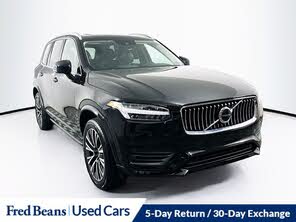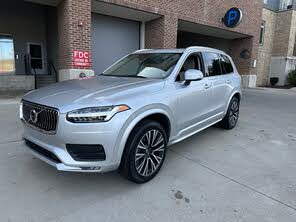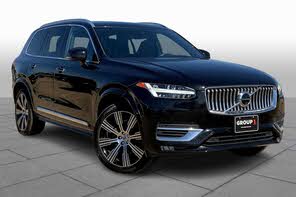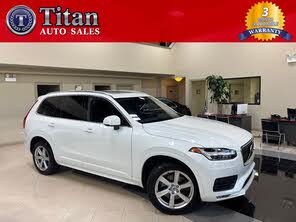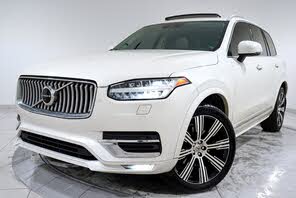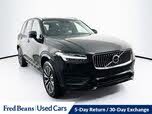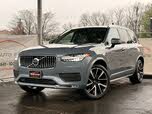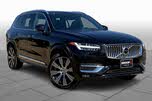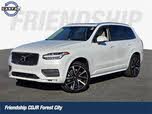2021 Volkswagen Atlas vs 2020 Volvo XC90
Overview | |
MSRP$48,350 | MSRP$31,545 |
Listings301 | Listings1264 |
Ratings & Reviews | |
User Reviews | User Reviews |
Expert reviews8.5 out of 10 | Expert reviews6.5 out of 10 |
Pros
Cons
| Pros
Cons
|
2020 Volvo XC90 Reviews SummaryThe XC90 has been one of our favorite family shuttles for 18 model years. This 3-row Volvo continues for 2020 as it was during its 2016 redesign, which brought dramatic new design language, chassis architecture, electrified powertrains, infotainment, and semi-automated driving capability. Among midsize SUVs, the XC90 is among the few I would recommend without any hesitation. Families who can afford to splurge will find a stylish and pampering truck that's built upon decades of safety research, which very few automakers can match. | |
2021 Volkswagen Atlas Reviews SummaryIntroduced for the 2018 model year, the Atlas is Volkswagen's latest attempt to win over American buyers. Built in Chattanooga, Tennessee, the VW Atlas competes in the three-row crossover SUV segment against well-established nameplates like the Ford Explorer, Honda Pilot, and Toyota Highlander. Changes for 2021 are limited to exterior styling tweaks and a reshuffled option list. VW also offers the two-row Atlas Cross Sport. | |
Popular Features & Specs | |
Engine2.0L 250 hp I4 | Engine2.0L 235 hp I4 |
Drive TrainFWD | Drive TrainFWD |
Seating Capacity7 | Seating Capacity7 |
Horsepower250 hp @ 5500 rpm | Horsepower |
MPG City21 | MPG City21 |
MPG Highway30 | MPG Highway24 |
Engine | |
Engine Name2.0L 250 hp I4 | Engine Name2.0L 235 hp I4 |
Torque258 lb-ft @ 1500 rpm | Torque |
Horsepower250 hp @ 5500 rpm | Horsepower |
DrivetrainFWD | DrivetrainFWD |
Fuel Economy | |
MPG City21 | MPG City21 |
MPG Highway30 | MPG Highway24 |
Interior | |
Seating Capacity7 | Seating Capacity7 |
Key Features | |
Sunroof/MoonroofStandard | Sunroof/Moonroof |
Safety | |
Front Crash Overall5 | Front Crash Overall4 |
Side Crash Overall5 | Side Crash Overall5 |
Dimensions & Capacity | |
Cargo Space15.8 cu ft | Cargo Space20.6 cu ft |
Curb Weight4375 lbs | Curb Weight4248 lbs |
Height69.9 in | Height70.1 in |
Length195.0 in | Length200.7 in |
Width84.3 in | Width78.4 in |
Wheelbase117.5 in | Wheelbase117.3 in |
Maximum Payload1210 lbs | Maximum Payload1080 lbs |
Number of doors4 | Number of doors4 |
Maximum Towing Capacity4000 lbs | Maximum Towing Capacity2000 lbs |
Overview | ||
MSRP | $48,350 | $31,545 |
Listings | ||
Ratings & Reviews | ||
User reviews | ||
Expert reviews | 8.5 out of 10Read full review | 6.5 out of 10Read full review |
Pros & cons | Pros
Cons
| Pros
Cons
|
Summary | The XC90 has been one of our favorite family shuttles for 18 model years. This 3-row Volvo continues for 2020 as it was during its 2016 redesign, which brought dramatic new design language, chassis architecture, electrified powertrains, infotainment, and semi-automated driving capability. Among midsize SUVs, the XC90 is among the few I would recommend without any hesitation. Families who can afford to splurge will find a stylish and pampering truck that's built upon decades of safety research, which very few automakers can match. | Introduced for the 2018 model year, the Atlas is Volkswagen's latest attempt to win over American buyers. Built in Chattanooga, Tennessee, the VW Atlas competes in the three-row crossover SUV segment against well-established nameplates like the Ford Explorer, Honda Pilot, and Toyota Highlander. Changes for 2021 are limited to exterior styling tweaks and a reshuffled option list. VW also offers the two-row Atlas Cross Sport. |
Video | ||
Popular Features & Specs | ||
Engine | 2.0L 250 hp I4 | 2.0L 235 hp I4 |
Drive Train | FWD | FWD |
Seating Capacity | 7 | 7 |
Horsepower | 250 hp @ 5500 rpm | |
MPG City | 21 | 21 |
MPG Highway | 30 | 24 |
Engine | ||
Engine Name | 2.0L 250 hp I4 | 2.0L 235 hp I4 |
Torque | 258 lb-ft @ 1500 rpm | |
Horsepower | 250 hp @ 5500 rpm | |
Drivetrain | FWD | FWD |
Fuel Economy | ||
MPG City | 21 | 21 |
MPG Highway | 30 | 24 |
Interior | ||
Seating Capacity | 7 | 7 |
Key Features | ||
Sunroof/Moonroof | Standard | |
Safety | ||
Front Crash Overall | 5 | 4 |
Side Crash Overall | 5 | 5 |
Dimensions & Capacity | ||
Cargo Space | 15.8 cu ft | 20.6 cu ft |
Curb Weight | 4375 lbs | 4248 lbs |
Height | 69.9 in | 70.1 in |
Length | 195.0 in | 200.7 in |
Width | 84.3 in | 78.4 in |
Wheelbase | 117.5 in | 117.3 in |
Maximum Payload | 1210 lbs | 1080 lbs |
Number of doors | 4 | 4 |
Maximum Towing Capacity | 4000 lbs | 2000 lbs |
When examining the 2020 Volvo XC90, one couldn’t help but admire the transformative leap Volvo had taken from its boxy sedans and wagons of the '80s and '90s. The XC90 epitomized an apex in Volvo’s design journey, proving that an SUV could possess a design elegance rivaling that of a low-slung sedan. The R-Design trim, particularly striking, featured blacked-out honeycomb grilles intersecting the iconic Volvo diagonal bar, alongside black accents on the window surrounds and mirrors, adding an edgy touch to its already sophisticated stature. The aggressive chin spoiler, complemented by 22-inch rims, enhanced its bold allure. Signature “Thor's Hammer” LED headlights, now standard, along with tall, curvaceous LED taillights, further marked its distinctive Volvo identity. The Thunder Grey Metallic paint juxtaposed with a beige-leather and aluminum interior created a captivating visual contrast that was both modern and luxurious.
In contrast, the 2021 Volkswagen Atlas embraced a more extroverted style with its refreshed front and rear bumpers, new grille, and standard LED headlights and taillights. The alterations extended its length by 2.4 inches, imparting a more substantial presence. The R-Line trim added sportier elements, including unique bumpers and side skirts, though the chrome exhaust tips felt somewhat contrived. The exterior updates, while purely cosmetic, gave the Atlas a more assertive look, albeit the truck-like aesthetics were less refined than Volvo’s sophisticated design. The minimalist interior, however, lacked the luxurious feel of the XC90, with lesser material quality and unconvincing faux wood and metal trims, especially evident in the mid-level SE with Technology model.


















The 2020 Volvo XC90 offered a range of powertrains, all based on a turbocharged 2.0-liter inline-4 coupled with an 8-speed automatic transmission. The entry-level T5 produced 250 horsepower and 258 pound-feet of torque but lacked the required power for a vehicle of this size. The T6 variant, with an added supercharger, boosted performance to 316 hp and 295 lb-ft, offering a more appropriate power level. The Polestar upgrade raised these figures to 330 hp and 325 lb-ft, although it did not transform the XC90 into a sporty machine. The T8 plug-in hybrid variant, with 400 hp and 472 lb-ft, offered an electric range of up to 18 miles thanks to its 11.6-kWh battery but added weight negated the advantages of power. Fuel economy for the T6 AWD was 18 mpg in the city, 26 on the highway, and 21 combined, which was underwhelming compared to its six-cylinder competition.
In comparison, the 2021 Volkswagen Atlas provided two engine options: a 2.0-liter turbocharged inline-four that generated 235 hp and 258 lb-ft, and a 3.6-liter VR6 with 276 hp and 266 lb-ft. Both engines were paired with an eight-speed automatic transmission. Front-wheel drive was standard, with optional 4Motion AWD that engaged only when necessary to save on fuel. The Atlas with the base engine and AWD felt underwhelming, delivering adequate acceleration but rough shifts and poor ride quality. The VR6 model’s towing capacity was a decent 5,000 pounds. Fuel economy for the four-cylinder AWD was 21 mpg combined, while the V6 AWD managed 18 mpg combined, which again fell short in comparison to rivals with hybrid powertrains.
In terms of interior space, the 2020 Volvo XC90 was built with a refined touch. Volvo’s Sensus infotainment system was faster and more intuitive compared to previous versions, though climate controls embedded in the touchscreen were less ergonomic. The XC90 offered seating for seven as standard, with an optional integrated booster cushion for second-row seats that was a thoughtful addition for families. The front and second rows promised substantial legroom and comfort, although the third row was cramped, suitable only for small children. The cargo capacity stood at 85.7 cubic feet with the rear seats folded, providing ample room for storage.
The 2021 Volkswagen Atlas, on the other hand, offered notable third-row legroom, making it more accommodating for larger families. However, this came at the expense of second-row comfort, which was compromised with thin, flat seat cushions. With all seats up, it provided 20.6 cubic feet of cargo space, expanding to 96.8 cubic feet with the seats folded, slightly more than the XC90. The controls were well placed and intuitive, clearly reflecting Volkswagen’s design philosophy seen in models like the Golf GTI. Additionally, it boasted up to 17 cupholders and five USB ports, enhancing its family-friendly credentials.
In the technology arena, the 2020 Volvo XC90 shined with its standard Pilot Assist, a semi-automated driving system that masterfully combined adaptive cruise control and lane-keep assist. The R-Design trim included a remarkable Bowers & Wilkins stereo with 1,400 watts, 19 speakers, including yellow Kevlar cones, offering a pristine audio experience. The 9-inch portrait-oriented touchscreen facilitated navigation, although onboard apps were slow to load.
The 2021 Volkswagen Atlas came equipped with Bluetooth and Apple CarPlay/Android Auto across all models. Lower trims had a 6.5-inch infotainment screen, while others featured an 8-inch panel. Higher trims could enjoy VW’s Digital Cockpit, replacing analog gauges with a 10.3-inch digital display. However, the overall interface was plain and text-heavy, making it less user-friendly. A new 4G LTE WiFi hotspot was a notable addition, allowing connectivity for up to four devices, complementing its family-oriented features.
Safety was a strong suit for both vehicles. The 2020 Volvo XC90 achieved top ratings from both the NHTSA and IIHS, though it fell short of the Top Safety Pick+ due to headlight performance. Standard features included forward emergency braking, pedestrian detection, blind-spot monitoring, and traffic-sign recognition. Volvo’s legacy of safety innovations, like the use of high-strength boron steel and advanced airbag systems, underlined their commitment to passenger protection.
The 2021 Volkswagen Atlas also garnered top “good” ratings from the IIHS but had mixed results in child-seat anchor and headlight evaluations. The 2020 Atlas model received a five-star overall rating from the NHTSA. Standard safety features for the 2021 model included automatic emergency braking and blind-spot monitoring, with higher trims offering adaptive cruise control, lane-keep assist, and traffic-jam assist. The expected addition of Travel Assist and Emergency Assist later in 2021 would enhance its safety credentials further.
CarGurus highlights

According to CarGurus experts, the overall rating for the 2020 Volvo XC90 is 8.5 out of 10, while the 2021 Volkswagen Atlas scores 6.5 out of 10. Based on these ratings, the 2020 Volvo XC90 emerges as the clear winner with its higher quality materials, advanced safety features, and superior technology. It offers a more refined driving experience, though at a slightly higher price point. The 2021 Volkswagen Atlas, while spacious and practical, falls short in overall refinement and performance, positioning it as a less compelling choice in this comparison. If you seek a luxurious and advanced SUV, the 2020 Volvo XC90 is the recommended pick.
Choose the 2021 Volkswagen Atlas if:
- Maximizing third-row legroom and overall passenger comfort is a top priority for your family needs.
- You require a more affordable base option with standard smartphone connectivity and decent tech features.
- The ability to tow up to 5,000 pounds with optional VR6 engine meets your utility needs.
Choose the 2020 Volvo XC90 if:
- You prioritize a luxurious interior with high-quality materials and advanced design.
- Advanced semi-automated driving features like Pilot Assist are essential for your driving experience.
- Outstanding audio quality is a must-have, exemplified by the premium Bowers & Wilkins stereo system.
CarGurus highlights

According to CarGurus experts, the overall rating for the 2020 Volvo XC90 is 8.5 out of 10, while the 2021 Volkswagen Atlas scores 6.5 out of 10. Based on these ratings, the 2020 Volvo XC90 emerges as the clear winner with its higher quality materials, advanced safety features, and superior technology. It offers a more refined driving experience, though at a slightly higher price point. The 2021 Volkswagen Atlas, while spacious and practical, falls short in overall refinement and performance, positioning it as a less compelling choice in this comparison. If you seek a luxurious and advanced SUV, the 2020 Volvo XC90 is the recommended pick.
Choose the 2021 Volkswagen Atlas if:
Shop Now- Maximizing third-row legroom and overall passenger comfort is a top priority for your family needs.
- You require a more affordable base option with standard smartphone connectivity and decent tech features.
- The ability to tow up to 5,000 pounds with optional VR6 engine meets your utility needs.
Choose the 2020 Volvo XC90 if:
Shop Now- You prioritize a luxurious interior with high-quality materials and advanced design.
- Advanced semi-automated driving features like Pilot Assist are essential for your driving experience.
- Outstanding audio quality is a must-have, exemplified by the premium Bowers & Wilkins stereo system.

By: CarGurus + AI
At CarGurus, our team of experienced automotive writers remain at the heart of our content operation, conducting hands-on car tests and writing insightful guides that are backed by years of industry experience. To complement this, we are harnessing AI to make our content offering more diverse and more helpful to shoppers than ever. To achieve this, our AI systems are based exclusively on CarGurus content, ratings and data, so that what we produce is both unique to CarGurus, and uniquely helpful to car shoppers.











